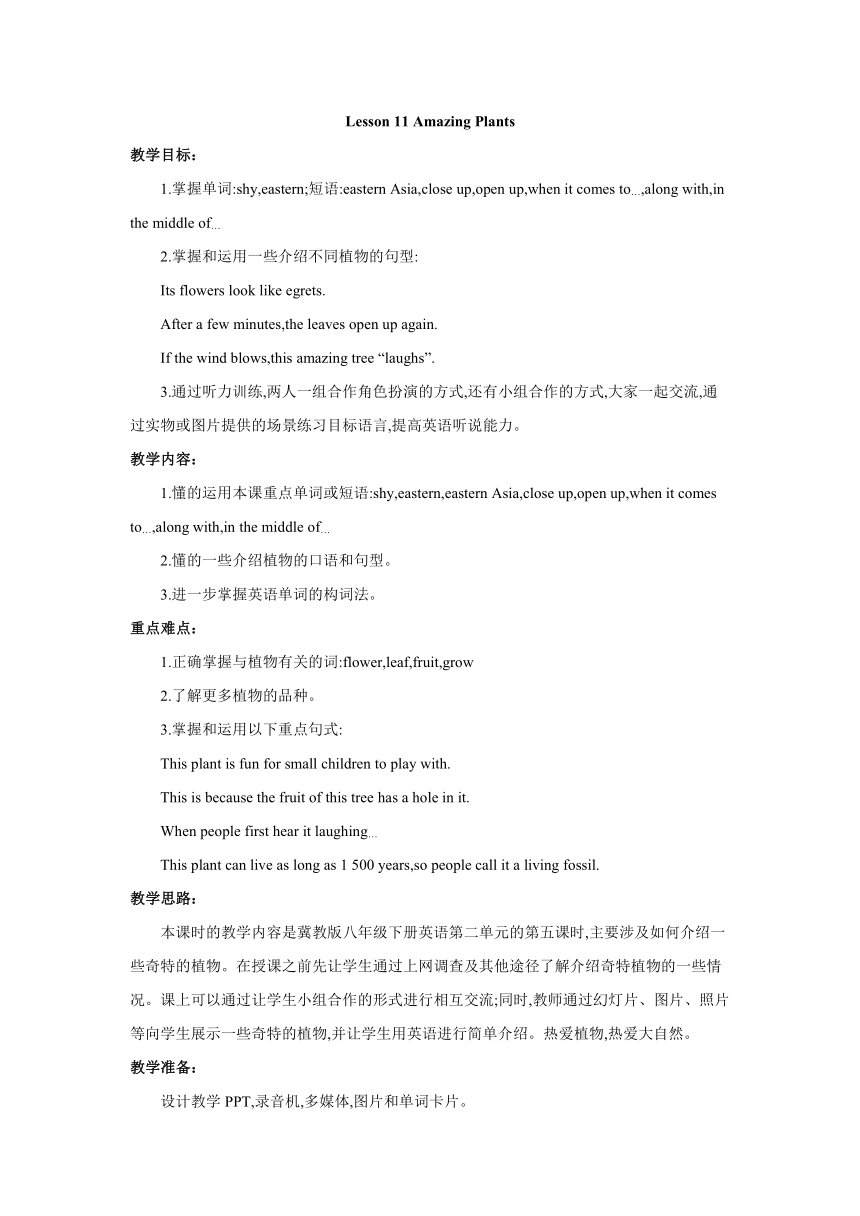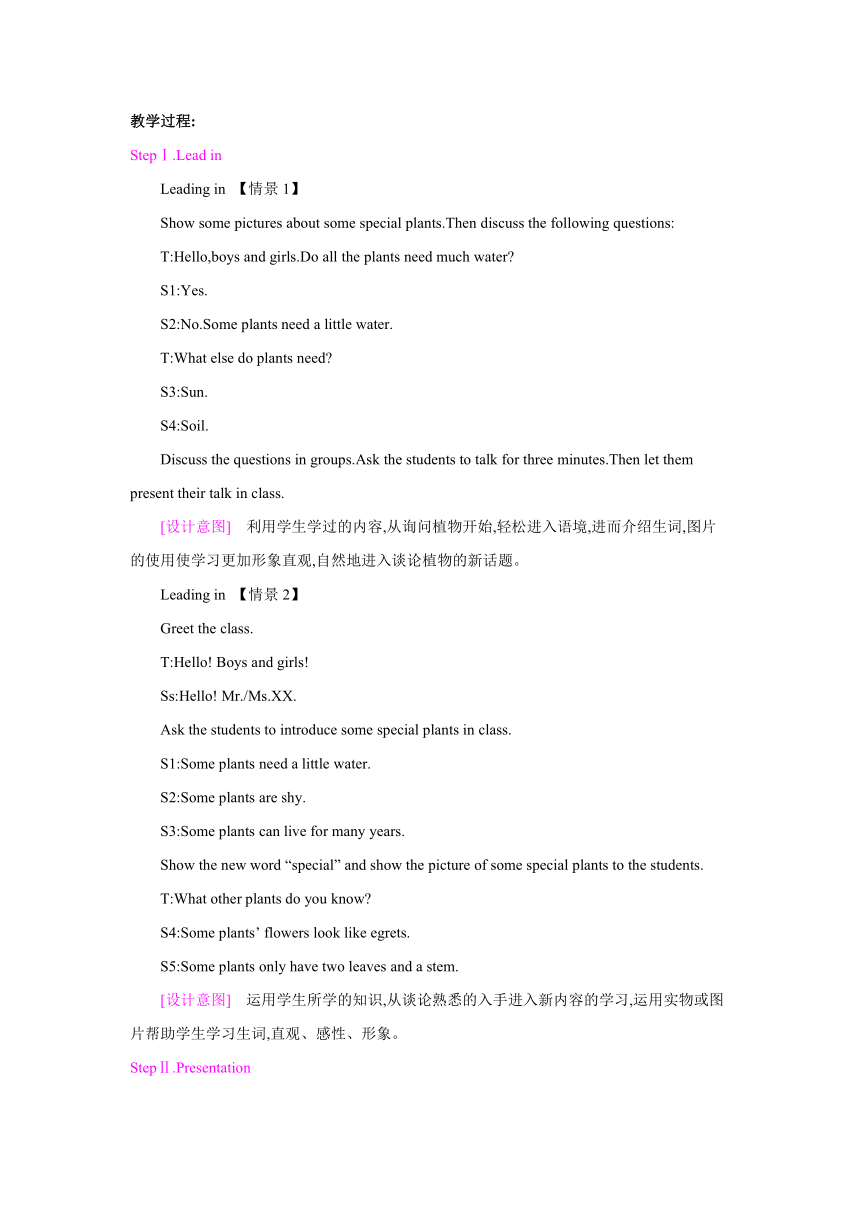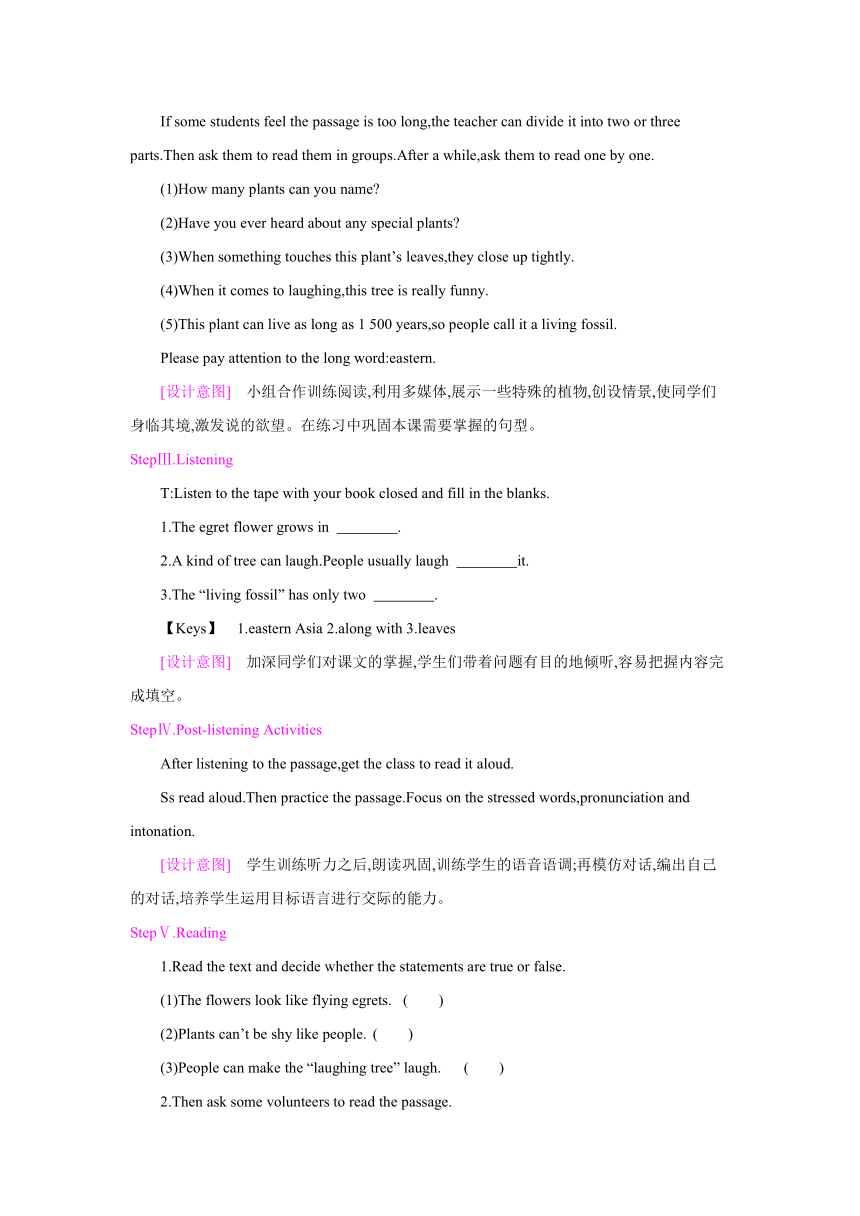Lesson 11 Amazing Plants 教学设计
文档属性
| 名称 | Lesson 11 Amazing Plants 教学设计 |  | |
| 格式 | zip | ||
| 文件大小 | 26.9KB | ||
| 资源类型 | 教案 | ||
| 版本资源 | 冀教版 | ||
| 科目 | 英语 | ||
| 更新时间 | 2019-06-28 08:28:53 | ||
图片预览



文档简介
Lesson 11 Amazing Plants
教学目标:
1.掌握单词:shy,eastern;短语:eastern Asia,close up,open up,when it comes to…,along with,in the middle of…
2.掌握和运用一些介绍不同植物的句型:
Its flowers look like egrets.
After a few minutes,the leaves open up again.
If the wind blows,this amazing tree “laughs”.
3.通过听力训练,两人一组合作角色扮演的方式,还有小组合作的方式,大家一起交流,通过实物或图片提供的场景练习目标语言,提高英语听说能力。
教学内容:
1.懂的运用本课重点单词或短语:shy,eastern,eastern Asia,close up,open up,when it comes to…,along with,in the middle of…
2.懂的一些介绍植物的口语和句型。
3.进一步掌握英语单词的构词法。
重点难点:
1.正确掌握与植物有关的词:flower,leaf,fruit,grow
2.了解更多植物的品种。
3.掌握和运用以下重点句式:
This plant is fun for small children to play with.
This is because the fruit of this tree has a hole in it.
When people first hear it laughing…
This plant can live as long as 1 500 years,so people call it a living fossil.
教学思路:
本课时的教学内容是冀教版八年级下册英语第二单元的第五课时,主要涉及如何介绍一些奇特的植物。在授课之前先让学生通过上网调查及其他途径了解介绍奇特植物的一些情况。课上可以通过让学生小组合作的形式进行相互交流;同时,教师通过幻灯片、图片、照片等向学生展示一些奇特的植物,并让学生用英语进行简单介绍。热爱植物,热爱大自然。
教学准备:
设计教学PPT,录音机,多媒体,图片和单词卡片。
教学过程:
StepⅠ.Lead in
Leading in 【情景1】
Show some pictures about some special plants.Then discuss the following questions:
T:Hello,boys and girls.Do all the plants need much water?
S1:Yes.
S2:No.Some plants need a little water.
T:What else do plants need?
S3:Sun.
S4:Soil.
Discuss the questions in groups.Ask the students to talk for three minutes.Then let them present their talk in class.
[设计意图] 利用学生学过的内容,从询问植物开始,轻松进入语境,进而介绍生词,图片的使用使学习更加形象直观,自然地进入谈论植物的新话题。
Leading in 【情景2】
Greet the class.
T:Hello! Boys and girls!
Ss:Hello! Mr./Ms.XX.
Ask the students to introduce some special plants in class.
S1:Some plants need a little water.
S2:Some plants are shy.
S3:Some plants can live for many years.
Show the new word “special” and show the picture of some special plants to the students.
T:What other plants do you know?
S4:Some plants’ flowers look like egrets.
S5:Some plants only have two leaves and a stem.
[设计意图] 运用学生所学的知识,从谈论熟悉的入手进入新内容的学习,运用实物或图片帮助学生学习生词,直观、感性、形象。
StepⅡ.Presentation
If some students feel the passage is too long,the teacher can divide it into two or three parts.Then ask them to read them in groups.After a while,ask them to read one by one.
(1)How many plants can you name?
(2)Have you ever heard about any special plants?
(3)When something touches this plant’s leaves,they close up tightly.
(4)When it comes to laughing,this tree is really funny.
(5)This plant can live as long as 1 500 years,so people call it a living fossil.
Please pay attention to the long word:eastern.
[设计意图] 小组合作训练阅读,利用多媒体,展示一些特殊的植物,创设情景,使同学们身临其境,激发说的欲望。在练习中巩固本课需要掌握的句型。
StepⅢ.Listening
T:Listen to the tape with your book closed and fill in the blanks.
1.The egret flower grows in .?
2.A kind of tree can laugh.People usually laugh it.?
3.The “living fossil” has only two .?
【Keys】 1.eastern Asia 2.along with 3.leaves
[设计意图] 加深同学们对课文的掌握,学生们带着问题有目的地倾听,容易把握内容完成填空。
StepⅣ.Post-listening Activities
After listening to the passage,get the class to read it aloud.
Ss read aloud.Then practice the passage.Focus on the stressed words,pronunciation and intonation.
[设计意图] 学生训练听力之后,朗读巩固,训练学生的语音语调;再模仿对话,编出自己的对话,培养学生运用目标语言进行交际的能力。
StepⅤ.Reading
1.Read the text and decide whether the statements are true or false.
(1)The flowers look like flying egrets. ( )
(2)Plants can’t be shy like people. ( )
(3)People can make the “laughing tree” laugh. ( )
2.Then ask some volunteers to read the passage.
3.Read the text again and fill in the blanks.
(1)This plant is fun for small children to .?
(2)This is the fruit of this tree has a hole in it.?
(3)When people hear it laughing, they are usually .?
(4)This plant can live 1 500 years, so people call it a living fossil.?
【Keys】 1.(1)T (2)F (3)F 3.(1)play with (2)because (3)first,surprised (4)as long as
☆教材解读☆
1.How many plants can you name??
(1)name作动词,意思是“说出……的名称;叫出……的名字”。
Can you name all the students?
你能叫出所有学生的名字吗?
(2)name作动词时还可以当“命名”讲,常用于name sb sth,意为“给某人取名叫……”。
She named her son Tom.
她给儿子取名叫汤姆。
(3)name sb/sth after sb/sth意为“以某人或者某物的名字给某人或者某物命名”。
She was named after her mother.
她是以她母亲的名字取的名。
2.Have you ever heard about any special plants??
hear about意思是“听说”,相当于hear of,一般指间接地听说某事某人。其中about 和of都是介词,后面可以接名词、代词或者动名词作宾语,不能接句子。
I have never heard about/of this story.
我从未听说过这个故事。
【拓展】 (1)hear 单独当“听到,听见”讲,强调“听”的结果,不能用于进行时态和祈使句中。后面可以接名词、代词或者that 从句和wh-从句。
I can hear you.我能听见你说话。
(2)hear from 意思是“收到……的信件”,相当于get a letter from sb。
She heard from him today.
她今天收到了他的来信。
3.When something touches this plant’s leaves,they close up tightly.?
close up意思是“合起来;收起来”,它是由“动词+副词”构成的短语,若其后接的宾语是代词,放在中间,若其后是名词,放中间或后面都可以。
Books are everywhere.Please close them up,Lucy! 书到处都是。露西,请把它们收起来!
Please close your books up.
=Please close up your books.
请收好你的书。
【拓展】 (1)close up 的其他含义:商店歇业;伤口愈合;思想上避而不谈。
(2)close up的反义词组为open up,意思是“张开;打开”,用法上和close up 一样。
4.When it comes to laughing,this tree is really funny.?
when it comes to意思是“就……而论”,其后接名词、代词或动名词作宾语。
When it comes to fishing,no one beats her.提到钓鱼,没人比她强。
When it comes to talking about the schoolwork,she is very active.一提到学习,她非常活跃。
5.This plant can live as long as 1 500 years,so people call it a living fossil.?
living在这儿是形容词,意思是“活着的”,它的反义词是 dead。
【拓展】 living还可以作名词,意思是“生计”,一般用单数形式,常用于短语make a living中,表示“谋生”。
To make a living,she had to sell clothes.
她不得不以卖衣服为生。
【辨析】 living,alive,lively
(1)living意思是“活着的;活的;在使用的”,常作定语,放在其修饰词的前面。
She is the finest living scientist.
她是当世最杰出的科学家。
(2)alive 意思是“活着的;在世的”,常作表语,也可以作定语,但必须放在其所修饰的词之后。
People alive are lucky.
活着的人是幸运的。
(3)lively 意思是“活泼的;生机勃勃的”,可用于修饰人或其行为动作,还可以修饰事物。
He is a lively boy.他是一个活泼的男孩。
[设计意图] 学生通过阅读课文,了解重点内容,并且通过判断对错来巩固对课文的理解和掌握; 朗读课文,利用填空的方式加深对课文的了解。
StepⅥ.Complete Let’s Do It!
Ask the students to listen to the tape and number the sentences in No.1.Then read the passage again and fill in the blanks in No.2 and No.3.
[设计意图] Let’s Do It! 部分中的No.1重点是听说教学,与课文内容有关系,以听力的形式,既巩固了课文,又训练了听力;No. 2考查对课文的掌握,读懂课文就可以回答。No.3考查文中重点单词的了解和掌握,练习题的形式使学生又一次巩固了文中重点词汇。
StepⅦ.Task
GROUP WORK:Let’s Do It! No.4
Ask some students to come to the front of the classroom in groups and finish No.4.
[设计意图] No.4的重点是阅读训练。同学们通过小组合作来完成练习。以谈论令人惊奇的植物为话题,课文已经给出了一些句子,提供了一个语境完整、内容丰富的话题,自然呈现本单元的核心句型,为学生进一步掌握课文做了巩固。小组合作的形式,训练学生的合作意识,小组之间的竞争,激发学生的积极性。
Step Ⅷ.Exercises
T:Now,look at the sentences with some missing words.Please use proper words to fill them.
1.Have you (听说) that news??
2. (当提到) cooking,I can only eat.?
3.Pandas are (害羞) animals.?
4.The boss wants to (关闭) the shop.?
5.This (种类) plants lives in China.?
【Keys】 1.heard about 2.When it comes to 3.shy 4.close up 5.kind of
[设计意图] 以学评教、强化落实。当堂检测主要是由本节内容组成的形成性评价,利用已知的信息,让学生补充,让他们得到充分的训练。
StepⅨ.Homework
1.Practice the passage with your group members after class.
2.Copy the new words twice.
[设计意图] 口头练习和单词记忆相结合,复习、归纳,注重语言知识的操练与积累。
Lesson 11 Amazing Plants
shy,eastern
eastern Asia,close up,open up,when it comes to…,
along with,in the middle of…
This plant is fun for small children to play with.
This is because the fruit of this tree has a hole in it.
When people first hear it laughing…
This plant can live as long as 1 500 years,so people call it a living fossil.
教材习题解答
【Lesson 11】
3 1.touch 2.eastern 3.shy 4.surprised
教学目标:
1.掌握单词:shy,eastern;短语:eastern Asia,close up,open up,when it comes to…,along with,in the middle of…
2.掌握和运用一些介绍不同植物的句型:
Its flowers look like egrets.
After a few minutes,the leaves open up again.
If the wind blows,this amazing tree “laughs”.
3.通过听力训练,两人一组合作角色扮演的方式,还有小组合作的方式,大家一起交流,通过实物或图片提供的场景练习目标语言,提高英语听说能力。
教学内容:
1.懂的运用本课重点单词或短语:shy,eastern,eastern Asia,close up,open up,when it comes to…,along with,in the middle of…
2.懂的一些介绍植物的口语和句型。
3.进一步掌握英语单词的构词法。
重点难点:
1.正确掌握与植物有关的词:flower,leaf,fruit,grow
2.了解更多植物的品种。
3.掌握和运用以下重点句式:
This plant is fun for small children to play with.
This is because the fruit of this tree has a hole in it.
When people first hear it laughing…
This plant can live as long as 1 500 years,so people call it a living fossil.
教学思路:
本课时的教学内容是冀教版八年级下册英语第二单元的第五课时,主要涉及如何介绍一些奇特的植物。在授课之前先让学生通过上网调查及其他途径了解介绍奇特植物的一些情况。课上可以通过让学生小组合作的形式进行相互交流;同时,教师通过幻灯片、图片、照片等向学生展示一些奇特的植物,并让学生用英语进行简单介绍。热爱植物,热爱大自然。
教学准备:
设计教学PPT,录音机,多媒体,图片和单词卡片。
教学过程:
StepⅠ.Lead in
Leading in 【情景1】
Show some pictures about some special plants.Then discuss the following questions:
T:Hello,boys and girls.Do all the plants need much water?
S1:Yes.
S2:No.Some plants need a little water.
T:What else do plants need?
S3:Sun.
S4:Soil.
Discuss the questions in groups.Ask the students to talk for three minutes.Then let them present their talk in class.
[设计意图] 利用学生学过的内容,从询问植物开始,轻松进入语境,进而介绍生词,图片的使用使学习更加形象直观,自然地进入谈论植物的新话题。
Leading in 【情景2】
Greet the class.
T:Hello! Boys and girls!
Ss:Hello! Mr./Ms.XX.
Ask the students to introduce some special plants in class.
S1:Some plants need a little water.
S2:Some plants are shy.
S3:Some plants can live for many years.
Show the new word “special” and show the picture of some special plants to the students.
T:What other plants do you know?
S4:Some plants’ flowers look like egrets.
S5:Some plants only have two leaves and a stem.
[设计意图] 运用学生所学的知识,从谈论熟悉的入手进入新内容的学习,运用实物或图片帮助学生学习生词,直观、感性、形象。
StepⅡ.Presentation
If some students feel the passage is too long,the teacher can divide it into two or three parts.Then ask them to read them in groups.After a while,ask them to read one by one.
(1)How many plants can you name?
(2)Have you ever heard about any special plants?
(3)When something touches this plant’s leaves,they close up tightly.
(4)When it comes to laughing,this tree is really funny.
(5)This plant can live as long as 1 500 years,so people call it a living fossil.
Please pay attention to the long word:eastern.
[设计意图] 小组合作训练阅读,利用多媒体,展示一些特殊的植物,创设情景,使同学们身临其境,激发说的欲望。在练习中巩固本课需要掌握的句型。
StepⅢ.Listening
T:Listen to the tape with your book closed and fill in the blanks.
1.The egret flower grows in .?
2.A kind of tree can laugh.People usually laugh it.?
3.The “living fossil” has only two .?
【Keys】 1.eastern Asia 2.along with 3.leaves
[设计意图] 加深同学们对课文的掌握,学生们带着问题有目的地倾听,容易把握内容完成填空。
StepⅣ.Post-listening Activities
After listening to the passage,get the class to read it aloud.
Ss read aloud.Then practice the passage.Focus on the stressed words,pronunciation and intonation.
[设计意图] 学生训练听力之后,朗读巩固,训练学生的语音语调;再模仿对话,编出自己的对话,培养学生运用目标语言进行交际的能力。
StepⅤ.Reading
1.Read the text and decide whether the statements are true or false.
(1)The flowers look like flying egrets. ( )
(2)Plants can’t be shy like people. ( )
(3)People can make the “laughing tree” laugh. ( )
2.Then ask some volunteers to read the passage.
3.Read the text again and fill in the blanks.
(1)This plant is fun for small children to .?
(2)This is the fruit of this tree has a hole in it.?
(3)When people hear it laughing, they are usually .?
(4)This plant can live 1 500 years, so people call it a living fossil.?
【Keys】 1.(1)T (2)F (3)F 3.(1)play with (2)because (3)first,surprised (4)as long as
☆教材解读☆
1.How many plants can you name??
(1)name作动词,意思是“说出……的名称;叫出……的名字”。
Can you name all the students?
你能叫出所有学生的名字吗?
(2)name作动词时还可以当“命名”讲,常用于name sb sth,意为“给某人取名叫……”。
She named her son Tom.
她给儿子取名叫汤姆。
(3)name sb/sth after sb/sth意为“以某人或者某物的名字给某人或者某物命名”。
She was named after her mother.
她是以她母亲的名字取的名。
2.Have you ever heard about any special plants??
hear about意思是“听说”,相当于hear of,一般指间接地听说某事某人。其中about 和of都是介词,后面可以接名词、代词或者动名词作宾语,不能接句子。
I have never heard about/of this story.
我从未听说过这个故事。
【拓展】 (1)hear 单独当“听到,听见”讲,强调“听”的结果,不能用于进行时态和祈使句中。后面可以接名词、代词或者that 从句和wh-从句。
I can hear you.我能听见你说话。
(2)hear from 意思是“收到……的信件”,相当于get a letter from sb。
She heard from him today.
她今天收到了他的来信。
3.When something touches this plant’s leaves,they close up tightly.?
close up意思是“合起来;收起来”,它是由“动词+副词”构成的短语,若其后接的宾语是代词,放在中间,若其后是名词,放中间或后面都可以。
Books are everywhere.Please close them up,Lucy! 书到处都是。露西,请把它们收起来!
Please close your books up.
=Please close up your books.
请收好你的书。
【拓展】 (1)close up 的其他含义:商店歇业;伤口愈合;思想上避而不谈。
(2)close up的反义词组为open up,意思是“张开;打开”,用法上和close up 一样。
4.When it comes to laughing,this tree is really funny.?
when it comes to意思是“就……而论”,其后接名词、代词或动名词作宾语。
When it comes to fishing,no one beats her.提到钓鱼,没人比她强。
When it comes to talking about the schoolwork,she is very active.一提到学习,她非常活跃。
5.This plant can live as long as 1 500 years,so people call it a living fossil.?
living在这儿是形容词,意思是“活着的”,它的反义词是 dead。
【拓展】 living还可以作名词,意思是“生计”,一般用单数形式,常用于短语make a living中,表示“谋生”。
To make a living,she had to sell clothes.
她不得不以卖衣服为生。
【辨析】 living,alive,lively
(1)living意思是“活着的;活的;在使用的”,常作定语,放在其修饰词的前面。
She is the finest living scientist.
她是当世最杰出的科学家。
(2)alive 意思是“活着的;在世的”,常作表语,也可以作定语,但必须放在其所修饰的词之后。
People alive are lucky.
活着的人是幸运的。
(3)lively 意思是“活泼的;生机勃勃的”,可用于修饰人或其行为动作,还可以修饰事物。
He is a lively boy.他是一个活泼的男孩。
[设计意图] 学生通过阅读课文,了解重点内容,并且通过判断对错来巩固对课文的理解和掌握; 朗读课文,利用填空的方式加深对课文的了解。
StepⅥ.Complete Let’s Do It!
Ask the students to listen to the tape and number the sentences in No.1.Then read the passage again and fill in the blanks in No.2 and No.3.
[设计意图] Let’s Do It! 部分中的No.1重点是听说教学,与课文内容有关系,以听力的形式,既巩固了课文,又训练了听力;No. 2考查对课文的掌握,读懂课文就可以回答。No.3考查文中重点单词的了解和掌握,练习题的形式使学生又一次巩固了文中重点词汇。
StepⅦ.Task
GROUP WORK:Let’s Do It! No.4
Ask some students to come to the front of the classroom in groups and finish No.4.
[设计意图] No.4的重点是阅读训练。同学们通过小组合作来完成练习。以谈论令人惊奇的植物为话题,课文已经给出了一些句子,提供了一个语境完整、内容丰富的话题,自然呈现本单元的核心句型,为学生进一步掌握课文做了巩固。小组合作的形式,训练学生的合作意识,小组之间的竞争,激发学生的积极性。
Step Ⅷ.Exercises
T:Now,look at the sentences with some missing words.Please use proper words to fill them.
1.Have you (听说) that news??
2. (当提到) cooking,I can only eat.?
3.Pandas are (害羞) animals.?
4.The boss wants to (关闭) the shop.?
5.This (种类) plants lives in China.?
【Keys】 1.heard about 2.When it comes to 3.shy 4.close up 5.kind of
[设计意图] 以学评教、强化落实。当堂检测主要是由本节内容组成的形成性评价,利用已知的信息,让学生补充,让他们得到充分的训练。
StepⅨ.Homework
1.Practice the passage with your group members after class.
2.Copy the new words twice.
[设计意图] 口头练习和单词记忆相结合,复习、归纳,注重语言知识的操练与积累。
Lesson 11 Amazing Plants
shy,eastern
eastern Asia,close up,open up,when it comes to…,
along with,in the middle of…
This plant is fun for small children to play with.
This is because the fruit of this tree has a hole in it.
When people first hear it laughing…
This plant can live as long as 1 500 years,so people call it a living fossil.
教材习题解答
【Lesson 11】
3 1.touch 2.eastern 3.shy 4.surprised
同课章节目录
- Unit 1 Spring Is Coming
- Lesson 1 How's the weather?
- Lesson 2 It's Getting Warmer!
- Lesson 3 Sun Is Rising
- Lesson 4 The Spring City
- Lesson 5 Babysitting on a Spring Day
- Lesson 6 Stories about Spring
- Unit 2 Plant a Plant
- Lesson 7 Planting Trees
- Lesson 8 Why Are Plants Important?
- Lesson 9 Gardening with Mary
- Lesson 10 Make Your Garden Grow!
- Lesson 11 Amazing Plants
- Lesson 12 Danny's Plant
- Unit 3 Animals Are Our Friends
- Lesson 13 Danny's Big Scare
- Lesson 14 Amazing Animals
- Lesson 15 The Zoo Is Open
- Lesson 16 The Pear Escaped
- Lesson 17 Save the Tigers
- Lesson 18 Friendship Between Animals
- Unit 4 The Internet Connects Us
- Lesson 19 How Do You Use the Internet?
- Lesson 20 A Computer Helps!
- Lesson 21 Books or Computers?
- Lesson 22 Travel on the Internet
- Lesson 23 The Internet--Good or Bad?
- Lesson 24 An E-mail to Grandpa
- Unit 5 Buying and Selling
- Lesson 25 Raising Money
- Lesson 26 Cookies, Please!
- Lesson 27 Business English
- Lesson 28 Ms. Liu's Great Idea
- Lesson 29 How to Push a Product
- Lesson 30 A Cookie Sale
- Unit 6 Be a Champion!
- Lesson 31 Don't Fall, Danny
- Lesson 32 My Favourite Record
- Lesson 33 2800 Years of Sports
- Lesson 34 Modern Olympics
- Lesson 35 The Dream Team
- Lesson 36 Classroom Olympics
- Unit 7 Know Our World
- Lesson 37 Let's Learn Geography!
- Lesson 38 The World Is a Big Place
- Lesson 39 Ring Up or Call?
- Lesson 40 Body Language
- Lesson 41 A Class of the World
- Lesson 42 North America
- Unit 8 Save Our World
- Lesson 43 Let's Clean Up!
- Lesson 44 Environment Clubs
- Lesson 45 Let's Sort Garbage!
- Lesson 46 Protect Our Environment
- Lesson 47 Connected to Nature
- Lesson 48 Garbage Is Interesting!
